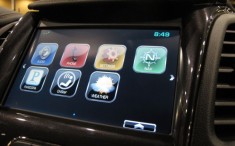 For some of their fans, Chevys will always be the ultimate All-American cars. That means, if not actually (per Don Maclean) driving them ‘to the levee when the levee is dry’, then at least worshipping at the altar of the classic Corvettes and Camaros from the sixties and seventies.
For some of their fans, Chevys will always be the ultimate All-American cars. That means, if not actually (per Don Maclean) driving them ‘to the levee when the levee is dry’, then at least worshipping at the altar of the classic Corvettes and Camaros from the sixties and seventies.
That said, the company is wise to the fact that even nostalgia buffs get excited when smart technology comes their way. No surprise then that the newer models
like the Sonic, Spark and Malibu, and even the new Chevrolet Camaro, come with Chevy’s Mylink Infotainment System, which for a product from a supposedly retro-minded firm, actually steps up to the tech plate pretty well.
First point to note (and congratulate Chevy on) is that the 2013 Mylink does not try to fight the smartphone any longer. That is a good thing. Why? Because previous in-car systems, while insisting on running their own platforms, inevitably soon lagged behind the yearly surge of new apps. You pay a fortune for them, and a year later you have something you feel faintly embarrassed about.
By contrast, the Mylink system is built around the principal of the driver’s smartphone being the primary source of apps. A Bluetooth connections means you can use any app you have downloaded on your phone in the car.
The obvious place to start when testing this out is in-car navigation. No longer are you forced to accept an imposed system. The choice of navigation app is yours, and while GM (Chevy’s parent) have provided their own gogolink nav app, you’re equally free to use another one such as Bringo with its choice of 2-D or 3-D map interfaces, the latter of which comes with cheery green trees on the horizon, even in the middle of a city (yes, it’s touches like that which are important).
Second key factor in the Mylink – and it builds on the first – is the integration of voice recognition. There is a touchscreen display to the dashboard mounted system, but because it’s not ideal to be fiddling with this while driving, voice recognition has long been seen as a key, but costly, feature of high level in-car infotainment. Again the Mylink’s smartphone integration does away with complications by allowing drivers to use the voice recognition installed on their own smartphones. A sophisticated app like Voice Action for Android, means you can ask for a specific song to be played from your phone’s playlist, or call up a friend in your address book, without getting something completely different because the inadequate VR thinks you’re speaking Swahili. Point scored, well done Chevy.
Are there any limitations to the Mylink? Well, some people might quibble that videos can only be viewed on the seven inch screen when the vehicle is in park transmission mode. However, on safety grounds that seems pretty sensible. What one might query is the fact that on the different models of car (Camaro, Sonic, Traverse, Malibu) offering Mylink, the physical set-up of the system is slightly different. There seems to be no good reason for that, other than perhaps to create the illusion that in the more expensive models, the Infotainment system is somehow better than in the cheaper ones. In reality, what Chevy have done in making car-infotainment smart phone compatible, is prove that a one-size-fits-all template is possible. It’s all about the smartphone, and the apps you have, not the hardware in the car. And for that they should be congratulated.

